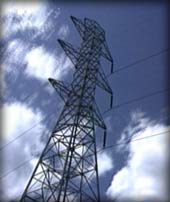Breaking News and Breaking Wind in Southwest Minnesota
August 29th, 2005

Power line capacity at center of debate in western Minnesota
The Big Stone project includes two separate power line corridors. The southern transmission line runs about 90 miles to Granite Falls. The northern route is about 60 miles long and will end at either Morris or Willmar.
Big Stone spokesman Steve Schultz says talks are taking place concerning the size of the lines. Schultz says the utilities may change the planned 230,000 volt southern route.
“They’re looking at that as a possibility, building that at 345,000 volts,” says Schultz. “Which would allow more outlet capability for wind projects.”
Wind supporters say if that happens it’s a step forward, but they also want the northern route upgraded to a larger carrying capacity. Wind advocate Brent Olson says only the larger size will guarantee room on the transmission lines for renewable energy.
Let’s think about this a bit — all they’ve talked about is voltage. VOLTAGE SAYS NOTHING ABOUT CAPACITY! EARTH TO MARS, TALK MVA TO ME!
Let’s take another look at “Transmission for Wind” in case any of you have missed it. Here’s a link for the conductor chart from Xcel’s approved and permitted Application the SW Minnesota Transmission Proceedings that shows that your basic 230kV line with ACSS conductor, which Xcel claims is now standard, already handles just a touch more than the 600MW of Big Stone. Ex. 35, App. 7. Download file If it’s a bundled line, and I can’t see why they wouldn’t bundle anything they’re building towers for, it’s twice that. The 115/161kV line for Chisago is 848MVA or so. The yellow highlighting is for the SW MN 345kV conductor specs, 2085MVA.
Here’s a link for the MAPP Form 1 showing the same 2085MVA for those who refuse to believe. Download file
And while I’m at it, attached also are the powerflows showing 213-302MVA of that 2085 MVA capacity of that line is from Buff Ridge. So maybe, MAYBE, just a hair over 10% of the capacity of this line is for wind. Download file 213MVA is the 50/50 option where generation is split between north and south as it is, 302 is the 100/0 best case scenario with all generation development in the south and more going into that 345kV line.
I found that SW Incremental Study that shows that the Buff Ridge wind energy is taking the scenic route through Dorsey, Manitoba, then over to Forbes (near the Arrowhead Sub) and then down to Chisago County sub, but it’s way too big to upload.
What the wind gives, line loss taketh away. …sigh… and here we go again, transmission “for wind.”
Leave a Reply